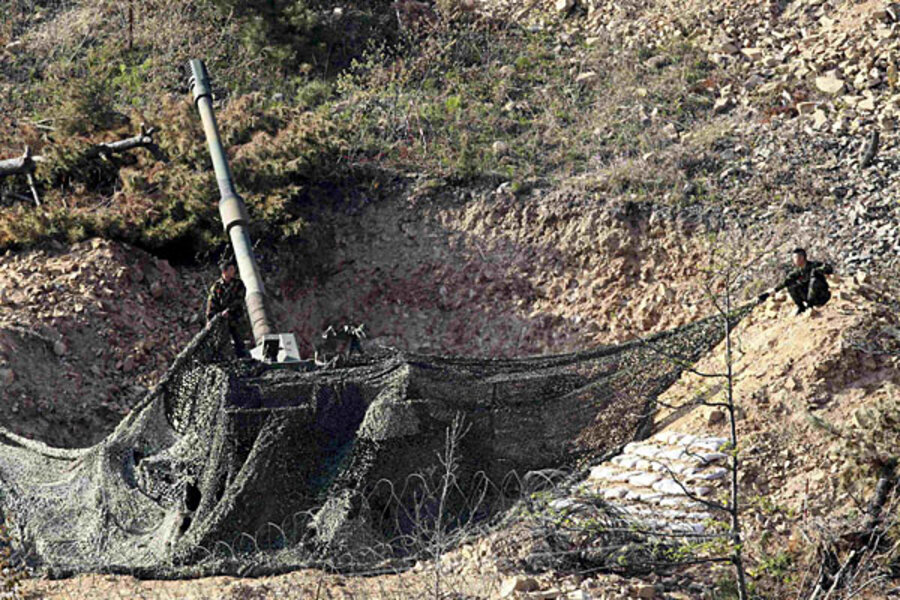South Korea shooting mishap highlights heightened tensions with North
Loading...
| Seoul, South Korea
For ten minutes at dawn on Friday, two young South Korean marines fired repeatedly at a low-flying plane they believed was a North Korean fighter.
The shots all fell short, and the plane turned out to be a passenger jet owned by Asiana Airlines, one of South Korea’s two major carriers, on final approach to Incheon International Airport, opened ten years ago as the main gateway into the country.
“This is a small happening,” says Song Hye-jung, a senior reservation manager at Asiana. “They only have small guns, so they cannot reach the plane.”
The episode, however, highlights heightened tensions in a region of long-running confrontation, including two attacks last year in which 50 South Koreans were killed. South Korean forces are building up on five or six islands in the Yellow Sea within sight of North Korea’s southwestern coast, primed to deter a repeat of the attack in November in which two marines and two civilians were killed in an artillery barrage on Yeonpyeong Island.
“The marines there are on high alert,” says Kim Tae-woo, senior research fellow at the Korea Institute for Defense Analyses. “Right after Yeonpyeong Island, there was a drastic strengthening of arms. Now our joint chiefs of staff are establishing long-range plans. There will be an intensification of plans.”
Missile tests
Besides sending more troops, tanks, and artillery pieces to the islands, South Korea reportedly has moved missiles to within range of North Korea’s capital of Pyongyang. North Korea, which manufactures short, medium and long-range missiles, recently tested one of its short-range missiles in the Yellow Sea – far from disputed waters but close enough to send a message.
In the case of the incident on Friday, according to the version of South Korean defense officials, the two marines, manning an observation post on Gyodong Island, slightly over a mile from North Korean territory, believed the plane was north of the usual route
“The control system has no direct connection to the troops out there on the island,” says Mr. Kim. “They simply did what they were ordered to do.”
In that atmosphere, however, the question arises about the safety of flying into an international airport capable of handling more than 1,000 flights a day within 20 miles of North Korea. Rhetorical exchanges between North and South Korea suggest the dangers.
'Fighting spirit'
South Korea’s President Lee Myung-bak, criticized for not responding strongly enough to the Yeonpyeong Island attack or to the sinking of the navy corvette the Cheonan in the Yellow Sea in March of last year with a loss of 46 sailors, called on South Korean forces last week to show “fighting spirit.” His defense minister, Kim Kwan-jin, warned of a “surprise provocation” while North Korea “is pressuring us with rhetorical threats.”
It was just such a surprise that the young marines were determined to combat, according to military sources. “They were so anxious,” says a military spokesman, Lieutenant Colonel Lee Song-il. “There will be no charges against them.”
One reason the two marines do not face disciplinary action is the view that the plane, on a flight from the northwestern Chinese city of Chengdu with 119 passengers and crew members aboard, was slightly north of its normal course when it passed over the island, about 20 miles west of Incheon.
Their version differs from that of the airline, which insists the plane was on course. “We only fly the normal route,” says Song Hye-jung of Asiana. “They are searching for the reason for misunderstanding.” No one on the plane had any idea what was happening – and learned about it only after landing.
Lessons from the close call?
Definitely, military and civilian officials are coordinating to guarantee no repetition of an experience seen as a warning to all. In a worst case scenario, they note, the marines could have been manning anti-aircraft artillery guns that could easily have blown the plane out of the sky.
“The tension was very high,” says Choi Jin-wook, director of North Korean studies at the Korea Institute of National Unification. “North Korea’s provocative remarks give the idea they are going to start a war. The marines were ordered to shoot at anything suspicious.”
Tensions flared earlier when North Korea threatened to fire on South Korean military exercises in which images of the late “Great Leader” Kim Il-sung, his son, leader Kim Jong-il, and Kim Jong-il’s son and heir apparent Kim Jong-un were used as targets.
“North Korea is saying we are very close to war,” says Mr. Choi. He doubts, though, if the North will make good on such threats. “That’s very unlikely,” he says. “China does not want that” – a reference to China’s ultimate power over the North as the source of most of its food and other vital supplies.





